#openstructure
Explore tagged Tumblr posts
Text
vimeo
Over, Again – Thomas Lommée (OpenStructure). - Studio Nopqrst
0 notes
Photo

Atelierbezoek #zaventemateliers #lioneljadot #armandjonckers #openstructures #designmuseumgent #slainterieurontwerp #sintlucasacademiegent https://www.instagram.com/p/B8UIh9-AheE/?igshid=pn9yecj68gd7
#zaventemateliers#lioneljadot#armandjonckers#openstructures#designmuseumgent#slainterieurontwerp#sintlucasacademiegent
0 notes
Text
You gotta start somewhere
Hi all,
My name is Clémentine. I've been studying at Design Academy Eindhoven for three and a half years, and it is time for me to graduate!
Looking back to the person I was when I started the school, I can only notice my uncanny journey. I tried all kind of methods, felt comfortable in opposite styles and concepts, navigated in hazy thematics. I experienced not one, but three school departments, all of them having a completely different vision of design: "Man&Activity" (making, product design), the "Invisible Studio" (research-based) and finally the "Public/Private" department in which I will graduate.
As a summary of my years spent at the design academy, here are the different projects I have worked on so far, listed in chronological order. (!) I'm not proud of my first projects, which I feel no longer correspond to what I'm looking to develop in the future. Only the projects from 2021 until now really represent my current work.

> "Blop", 2018, a collection of small indoor watering can _ceramics + silicon pipe

> "Candy chair", 2018 _wood + expandable foam

> "DIY sledge", 2018, a sledge to build and unbuild easily using the OpenStructure 's system grid _scrap wood, various materials

> "Texo", 2019, a range of caps made out of recycled scaffolding nets

> "I-Sob", 2020, a sound-producing robot to create sound atmospheres _various materials

> "Lilipad-Template factory", 2020, a self-made machine allowing to emboss templates on plastic sheets to create small objects
> "Project O.1%", 2020, virtual experiments on disturbing textiles' production via a code (video) :


>"Ora", 2021, a collection of small objects inspired by the textures of ores from which metals are extracted _steel, stainless steel

>"ZigZag", 2021, collaboration with Piet Hein Eek, a series of shelf modules made from Piet Hein Eek's metal leftovers _steel, stainless steel

>"Ashlar", 2021, a collection of outdoor furniture inspired by Inca masonnery techniques (dry stone)
None of these projects are really finished: I tend to spend way more time of the experiment/research phase than on the finishing phase. I hope to overcome this tendency and graduate with pieces that are perfectly finished, and could end up in a gallery or be sold. Definitely one of my objective!
As a start for my graduation project, I would like to improve/continue at least of of these projects, maybe two. I really like the "Ora" concept and the "Ashlar": it would be nice to find smart and beautiful way to improve both of them.
2 notes
·
View notes
Photo

Structural lightweight concretemade with ECA solves weight and durability problems in buildings and exposed structures. It offers strengths comparable to normal weight concrete, yet is typically 25% to 35% lighter. It offers design flexibility, substantial cost savings, less dead load, improved seismic structuralresponse, longer spans, better fire ratings, thinner sections, decreased story height. You may send in your enquiry to [email protected] or visit https://bit.ly/2NVd2wo #replacement #fineaggregatereplacement #coarseaggregatereplacement #lightweightaggregate #closedstructure #openstructure #compressivestrength #thermalisolation #lightweightconcrete #resistancetofire #onethirdweightcomparedtoordinaryconcrete #panels #barriers #posttensioningeffect #soundisolation #convinienttransportation #concretemixing #prefabricationplant #premixplant #readymixplant #groutwithopenstructure #15N/mm2to70N/mm2 #variabledensities (at Ahmedabad, India) https://www.instagram.com/p/BpZFu-wH-LM/?utm_source=ig_tumblr_share&igshid=5x4g46rejevj
#replacement#fineaggregatereplacement#coarseaggregatereplacement#lightweightaggregate#closedstructure#openstructure#compressivestrength#thermalisolation#lightweightconcrete#resistancetofire#onethirdweightcomparedtoordinaryconcrete#panels#barriers#posttensioningeffect#soundisolation#convinienttransportation#concretemixing#prefabricationplant#premixplant#readymixplant#groutwithopenstructure#15n#variabledensities
0 notes
Text
Aesthetics for hard solarpunk
Hard science fiction refers to when works of fiction stay very faithful to our current understanding of science - the fewer artistic liberties the work takes with its worldbuilding, the “harder” it is
Now I don’t typically interact with the literary aspect of solarpunk, focusing more on the practical, real-world work that needs to be done to get there. But I thought I might use the knowledge I have to give something of a framework for people who want to make solarpunk art that’s more grounded in realism than aesthetic - hence, hard solarpunk
3D printing
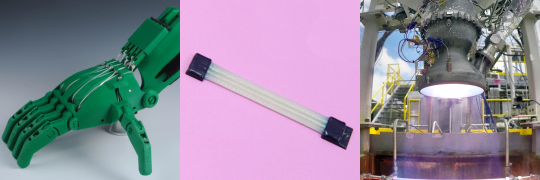
(Pictured: A Cyborg Beast prosthetic hand; a 4D-printed wire made in one process at GIT; Relativity Space’s 3D printed Aeon rocket engine)
3D printing is a precise, automated manufacturing process that’s accessible even to small communities, resulting in decentralized production and thus independence from multinationals. Local, bespoke production also eliminates the waste produced by packaging and shipping, making it ideal for a solarpunk setting - and its utility will only increase as the technology continues to develop. 3D printed objects of any material tend to have a wood-grain-like quality due to the layering process, which could be incorporated into your art or writing
Modularity
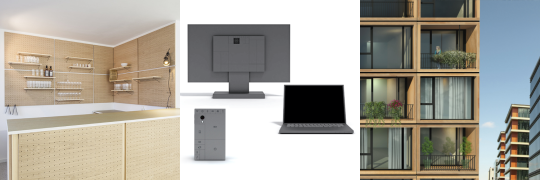
(Pictured: A bar built to the OpenStructures grid by Jonathan Karsilo; modular electronics concept by Phonebloks; modular housing design by Finch Buildings)
Modular systems have a host of benefits: easy replacement of broken parts, reuse of versatile modules, customization, simple assembly and disassembly, compatibility and open collaboration wherever the standard is used, mass production of multi-use parts, etc. All this results in simplified production and use, more efficient use of resources, and reduced waste. Modularity is typified by reusable assembly techniques such as nuts/bolts or snap-together mechanisms and by standard square grids (at least on the inside). It may not be as pretty as stained glass and art deco, but it’s much more sustainable!
Upcycling/reuse
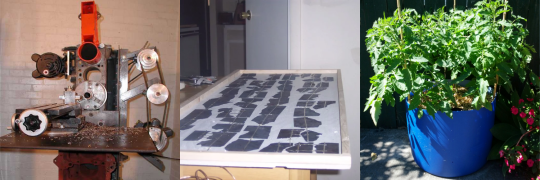
(Pictured: Pat Delaney’s MultiMachine, made largely of reused car parts; a DIY solar panel made of broken photovoltaic cells by mattfelice on Instructables; tomatoes growing in an upcycled plastic barrel by markt on growlust)
Recycling uses up energy and wastes materials, and of course landfilling isn’t an option, so whenever a broken, worn, or unneeded object can be modified and used again it should be. If modularity is adopted to a big enough extent, and if disposability culture is brutally and vengefully slaughtered, most reuse wouldn’t look much different from anything else - unless a part is broken to the extent that it can no longer fill its original purpose and must find a new one. In near-future settings, though, lots of parts from today’s society could be shown living new lives
Recycling
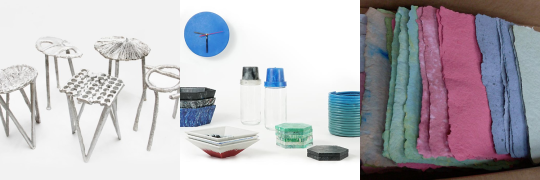
(Pictured: Stools made of aluminum cans using a mobile foundry by Studio Swine; several products made of recycled plastic using small-scale machines by Precious Plastic; homemade recycled paper by reondadomino on Instructables)
But when something is well and truly useless, its materials must be broken down and recycled. This probably wouldn’t look quite as clean as modern-day industrial recycling, though. Small-scale machines being used by communities dedicated to reducing as much waste as possible would probably throw similar-enough colors together to be melted, or use simpler techniques that give less-than-standard results. They’re still no less pretty, if you ask me
Low-tech alternatives
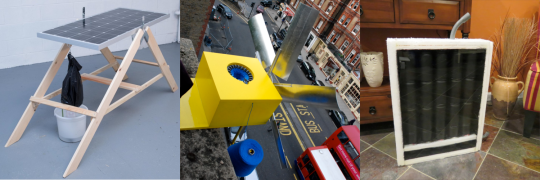
(Pictured: The SunSaluter, a gravity-powered solar tracker; a wind-powered knitting machine by Merel Karhof; a homemade solar greenhouse heater by the Rusted Garden)
Connecting a windmill to a dynamo only to have it run a motor, or a solar thermal generator to a turbine only to have it run a heater, is obviously wasteful. So is using a computer and a motor to do what a jug of water and a counterweight could do. Not only is energy lost at each interchange, but the wires, batteries, and other electrical components all use valuable resources that require lots of energy to mine, process, and ship. Solar cooking, heating, and lighting would be preferred when possible, and mechanical processes would often be run by windmills (possibly with human power as a backup) or water wheels. Not everything has to be high-tech!
Feel free to add other realistic solarpunk details!
1K notes
·
View notes
Text
Reconstrained Design (the book)
We have a new book, a catalogue of sorts, covering certain aspects of our work as the Reconstrained Design Group* over the past couple of years. It’s a handsome object full of nice words and images - some of which you may have seen first on this blog. There is also new material: for example, it features essays on Reconstrained Design by Lucy Suchman and Clive Dilnot. Please send us a message if you’re interested in receiving a copy.
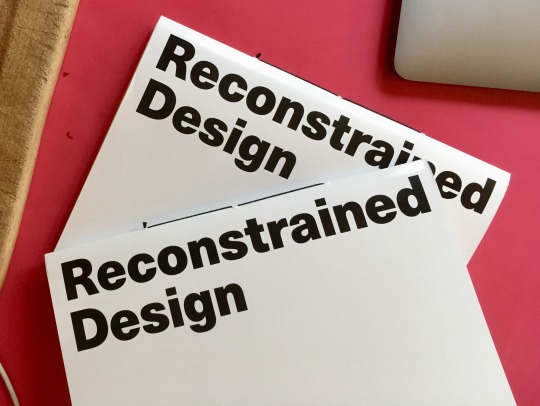
Here is a short piece from the book, ‘DIY Reconstrained’, written by ourselves and Enrique Encinas:
The three words that form the DIY acronym send a clear and empowering message: anyone can do it. You can do it. But do what? What needs to be done? For some, DIY resides in a shed at the back of the garden—the Reader’s Digest manual from the 1970s that tells you how to fix everything from a drainpipe to a typewriter. For others DIY suggests punk rock, a form of expression that requires only minimum skill to achieve satisfying results, and that builds around it an active community, rejecting the passivity of corporate consumerism.
DIY is rational resistance to an irrational consumer culture. Paul Mazur of Lehman Brothers declared in 1927: ‘We must shift America from a needs, to a desires culture.’ Public relations, advertising agencies, and designers answered Mazur’s call with methods appealing not to the rationality of citizens but to the irrational and subconscious drives of consumers. The marketplace boomed as selling bypassed the intellect to interact directly with the emotions. This near complete alteration of perspective puts DIY in a fragile position—impoverished by its more complex appeal, its objects struggle to compete with the hi-gloss culture of brands and fashion. For many consumers, the latest iteration of consumer electronic products exhibit a near sacred aura.
In Mythologies (1957) Roland Barthes describes this elevation of object status through the example of the Citroën DS, the ‘Goddess’—‘a superlative object’. He comments on the seamless perfection of the vehicle, likening it to the ‘unbroken metal’ of science-fiction spaceships and even to the smooth and seamless robes worn by Christ. Seams, he argues, reveal the hand of the (human) maker—methods of assembly and therefore dis-assembly (or fixing). In a sinister shift, this godlike approach to artefacts has become the celebrated norm of product design—think of Apple—where ‘perfection’ means not letting any grubby hands inside the pristine carapace of the technological device, not meddling with divine creation. How can DIY compete with such perfection?
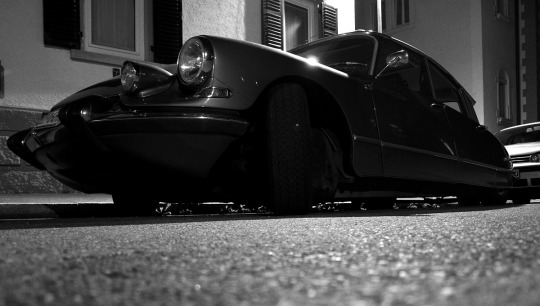
The deskilling of a generation of young people presents another problem for DIY, as schools focus too exclusively on new ways of making such as 3D printing and laser cutting. This has severely limited the scope of what can be made and by whom.
It was in the early 20th century that DIY, the ungenteel inheritor of the Arts and Crafts movement, got its name. Then and now, in the Maker Movement, DIY is viewed as a creative and/or recreational and/or money-saving activity. It is helpful, useful, and fun. It is as straightforward a practice as the end it wants to accomplish. Through a set of accessible premises, ‘shed’-style DIY launches the rational individual into a journey of self discovery and learning—a journey that normally ends when function is met and hence need is no more. As a good citizen, one finds in DIY the sensible alternative to a trip to the store. As a consumer embedded in a culture of desire, however, the workshop presents a real challenge—who has the time, access, or requisite knowledge? As with the Arts and Crafts movement, the Maker Movement risks simply being a mouthpiece for the middle classes, an outlet for those with the disposable time and income to temporarily reject the mainstream attitude towards objects and our interactions with them. So what can be done?
Royal detested this orthodoxy of the intelligent. Visiting his neighbours’ apartments, he would find himself physically repelled by the contours of an award-winning coffee pot, by the well-modulated color schemes, by the good taste and intelligence that, Midas-like, had transformed everything in these apartments into an ideal marriage of function and design. In a sense, these people were the vanguard of a well-to-do and well-educated proletariat of the future, boxed up in these expensive apartments with their elegant furniture, and intelligent sensibilities, and no possibility of escape.
- J.G. Ballard, High-Rise
Consumers have been programmed for sleek, seamless products far too long to accept the standard (non-designed) DIY aesthetic overnight. The desire for award-winning coffee pots (and phones, juicers, hair dryers, etc.) is strong, and for the time being Ballard is most likely right—there is no possibility of escape. This leaves two options: one easy, one very difficult.
The hard route: Adapt consumer desires to a maker aesthetic. Reprogramme people to be less obsessed with brands, or to see value in what is rough, cheap, or practical.
The various gravity batteries described in the Newton Machine project exemplify the approach with their focus on easy making over high-level production, found components over highly-refined, open-source over heavily patented and local materials over globally sourced. This is the first challenge we set in our manifesto—to reverse Mazur’s statement and return to a needs-based culture. But this is a slow-burning, long-term strategy.
The easier route: Adapt the DIY aesthetic to what people want. Introduce a better sense of design that allows maker products to compete with mainstream exemplars of good design such as Apple and Dyson. What would a DIY artefact like if it had the touch of Charles and Ray Eames? Or Dieter Rams? Or Enzo Mari? There aren’t many designed maker objects to be found. The OpenStructures WaterBoiler is one example of how such things could look. Originally designed by Jesse Howard and Thomas Lommée, it was adapted by Unfold, who replaced the PET bottles with a cut-through bottle (see Tord Boontje’s Transglass project for the potential of cut recycled glass) and used a combination of 3D-printed ceramic, off-the-shelf plumbing material and simple folded steel. If more objects like these were produced by the Maker Movement, there might be a chance of shifting consumer habits.

To complement our sometimes utilitarian approach, we are developing more designerly examples of Reconstrained Design addressing the complex notions of desire that drive conspicuous consumption. The Gravity Lamp and Gravity Turntable, for example, aim to provide a more direct challenge to contemporary design, by removing constraints imposed by its relationship to the market. The aim is not only to address stylistic issues but also the problem of making—that the route to ownership should not be constrained by a lack of skills or access to tools. The solution is to build a network of experts, professionals, and craftspeople, essentially decentralising DIY by engaging with the local community, its expertise and its resources. A DIY manual for a product could, for example, be a wiki that shows the constructive steps but also points the way to local cabinet makers or metal shops that will help to build sophisticated elements of a project. This approach would also support the survival of craft knowledge in local communities.
* The Reconstrained Design Group is James Auger, Julian Hanna, Laura Watts, Enrique Encinas, Mohammed Ali, and Parakram Pyakurel
Images:
Citroën DS 19; Enzo Mari by Adriano Alecchi (Mondadori Publishers) - both via Wikimedia Commons.
7 notes
·
View notes
Note
You should try and make your products compatible with the OpenStructures and Constructeur standards. Modularity is a massive benefit to efficiency and waste reduction, and you can mass-produce a handful of parts that could be used for multiple products!
Compatibility would be really important. The hope is that it would be so easy to integrate with other systems. Since it would be open source the library of 3rd party parts would grow quickly.
23 notes
·
View notes
Photo




(via OS > kids toys - The OpenStructures blog.)
36 notes
·
View notes
Photo

Op uitnodiging van de fantastische Alice Wong en het dito designduo Studio Plastique heb ik meegewerkt aan de expositie Transitions voor de Dutch Design Week, die vijf ontwerpers/studio's bij elkaar brengt die elk op hun eigen manier bezig zijn met belangrijke overgangen. Ik schreef de teksten voor de korte video's waarin de studio's zichzelf voorstellen; een heel leerzame ervaring. Ik heb in elk geval genoten van de gesprekken met Alice Wong, Studio Plastique, Resortecs, OpenStructures, Rotor DC en Amandine David. Bekijk de digitale presentatie via deze link. Lees meer over het project hier.
0 notes
Photo



Open Source Waterfilter
The Open Source Ceramic Waterfilter is an ongoing research project in collaboration with various research institutes on the potential benefits of using Unfold's unique ceramic 3D printing process for the production of water filters in the developing world. The first water filter is a prototype commissioned by OpenStructures for the 2012 Istanbul Design Biennial. The OpenStructures WaterBoiler, originally designed and composed by Jesse Howard in collaboration with Thomas Lommée. The WaterBoiler is based on the OpenStructures design principles. In Unfold's adaptation, the water recipient, a salvaged, PET bottle, was replaced by a cut-through glass bottle that holds a ceramic water filter 3D printed using one of the machines that they developed. It further contains OS compatible parts designed by Fabio Lorefice (3D printed adaptor piece). http://unfold.be/pages/open-source-waterfilter fig. 01-03: photography by Intrastructures
4 notes
·
View notes
Photo






Case Study- Library of Muyinga
For the library of Muyinga BC architects was asked to scale the “Open structures” model to an architectural level.A construction process involving end-users and second-hand economies was conceived, connected to product life cycles, water resource cycles and energy cycles. This OpenStructures architectural model was called “Case Study (CS) 1: Katanga, Congo”. It was theoretical, and fully research-based. Five years later, the library of Muyinga in Burundi is completed.
The library is organized along a longitudinal covered circulation space. This “hallway porch” is a space often encountered within the Burundian traditional housing as it provides a shelter from heavy rains and harsh sun. Life happens mostly in this hallway porch; encounters, resting, conversation, waiting – it is a truly social space, constitutive for community relations.
This hallway porch is deliberately oversized to become the extent of the library. Transparent doors between the columns create the interaction between inside space and porch. Fully opened, these doors make the library open up towards the adjacent square with breathtaking views over Burundi’s milles collines (“1000 hills”).
On the longitudinal end, the hallway porch flows onto the street, where blinders control access. These blinders are an important architectural element of the street facade, showing clearly when the library is open or closed. On the other end, the hallway porch will continue as the main circulation and acces space fot the future school.
The double room height at the street side gave the possibility to create a special space for the smallest of the library readers. This children’s space consist of a wooden sitting corner on the ground floor, which might facilitate cosy class readings. It is topped by an enormous hammock of sisal rope as a mezzanine, in which the children can dream away with the books that they are reading.
The future school will continue to swing intelligently through the landscape of the site, creating playgrounds and courtyards to accomodate existing slopes and trees. In the meanwhile, the library will work as an autonomous building with a finished design.
https://www.domusweb.it/en/architecture/2014/09/16/library_of_muyinga.html
My take
- Looking this case study i love how they utilized the space while creating a space that includes the natural features of where it is situated.
- The layering of spaces from floor to ceiling is one thing that i will consider when designing the Grey Lynn library.
- I appreciate the cultural significance of the building and think it contributes to the overall idea they wanted to accomplish
- The interactive features of the space
- The material- the natural, warm materials gives a welcoming feel to the space.
-the layout- the open space from the inside out promotes a community space, that is welcomed for all.
0 notes
Photo

English: The 3erlin Grid article is new. Check out how open circular design can work and be made for decentralised collaboration with #ConsistentGrids. Read here: https://mifactori.de/3erlin-grid/ Deutsch: Der 3erlin-Grid-Artikel ist neu. So kann offenes, nachhaltiges Kreislaufdesign funktionieren mit #ConsistentGrids. Hier lesen: https://mifactori.de/3erlin-grid/ #ConstistentGrids #3erlinGrid #OpenStructures # Circular #OpenDesign #OpenCircularDesign #CircularDesign #Circularity #ClimateChange #Design #Furniture #ModularDesign #DesignResearch #industrialdesign #sustainable #sustainabledesign (hier: Berlin, Germany) https://www.instagram.com/p/CI0TfgYn_0i/?igshid=1txwcnlwzztbx
#consistentgrids#constistentgrids#3erlingrid#openstructures#opendesign#opencirculardesign#circulardesign#circularity#climatechange#design#furniture#modulardesign#designresearch#industrialdesign#sustainable#sustainabledesign
0 notes
Photo

Anyone for everyone [32]
Openstructure parts which I made through this semester.
0 notes
Photo

From ‘Home Futures: Living in Yesterday's Tomorrow’ @designmuseum The first comprehensive survey of the 20th century’s aspirational, radical and futuristic visions of the home. Features work by Ettore Sottsass, Alison and Peter Smithson, Superstudio, Enzo Mari, Archigram, Dunne & Raby, OMA, Joe Colombo, Absalon, Ronan & Erwan Bouroullec, Atelier Van Lieshout, Yona Friedman, Buckminster Fuller, Richard Hamilton, Hans Hollein, Haus-Rucker-Co, Industrial Facility, Jan Kaplický, Frederick Kiesler, Linder, Enzo Mari, OpenStructures, Ugo la Pietra and many more. Looking back on more than a century of speculative design, ‘Home Futures’ proposes that we are already living in yesterday’s tomorrow—just not in the way anyone predicted. Edited by Eszter Steierhoffer & Justin McGuirk @esteierhoffer #homefutures #design #architecture #futuristic #livinginyesterdaystomorrow #futuristicdesign https://www.instagram.com/p/BwpLckNnCtn/?utm_source=ig_tumblr_share&igshid=290um1alx4lj
0 notes

